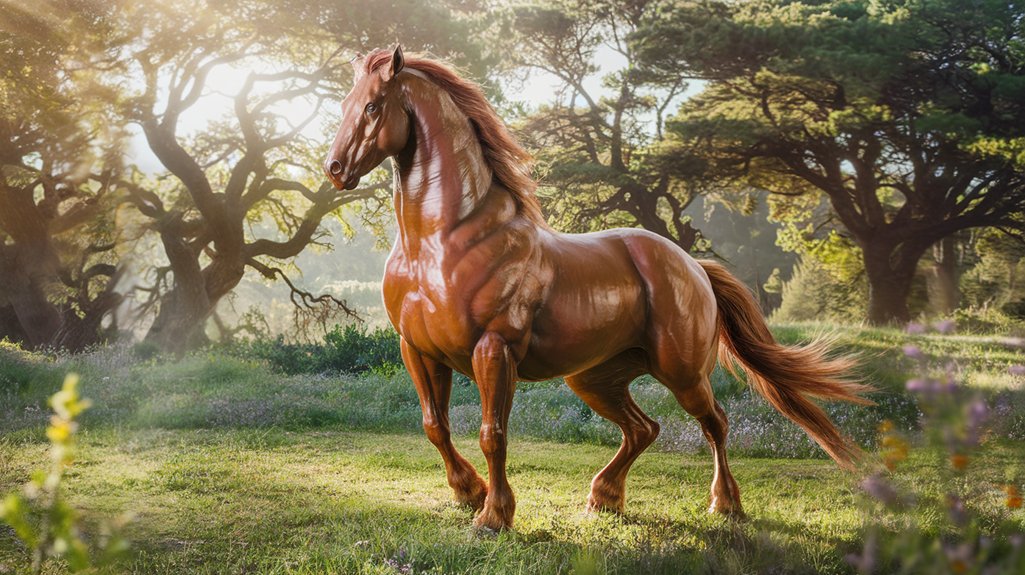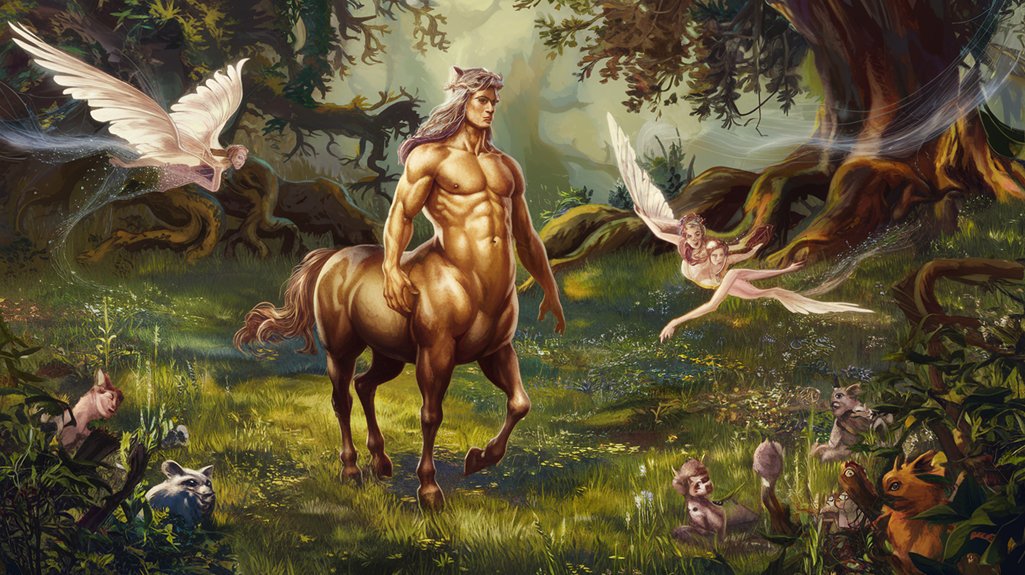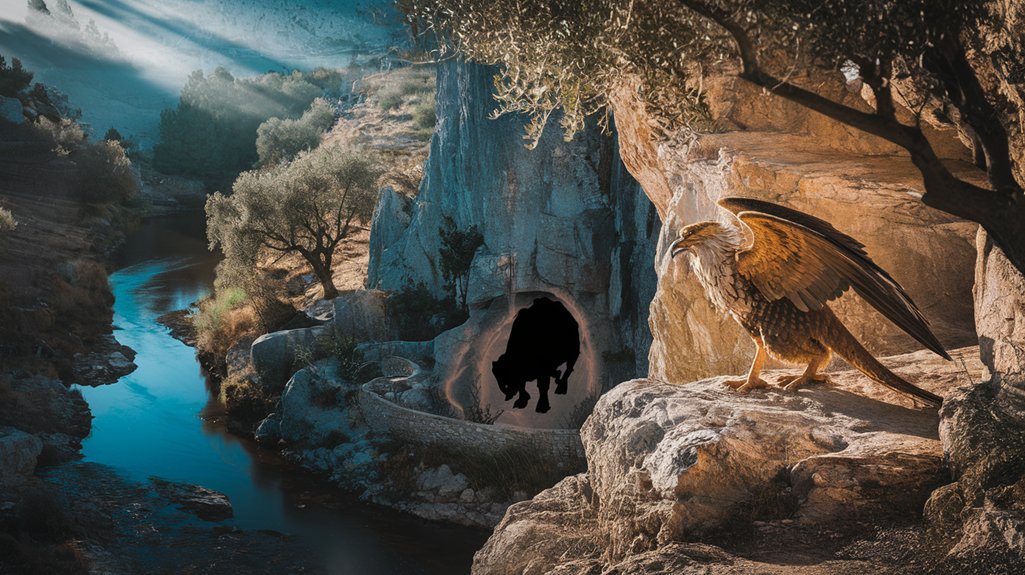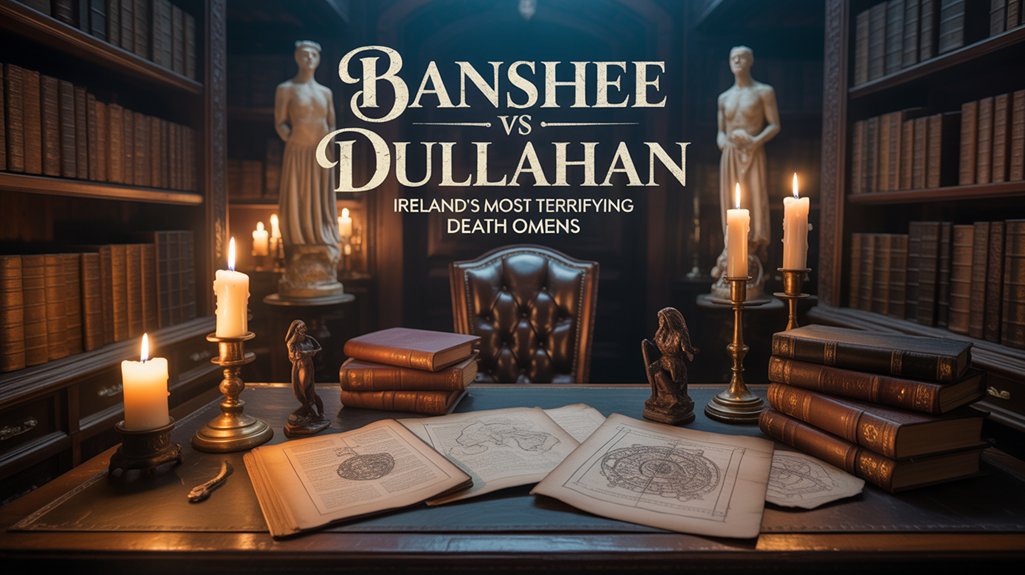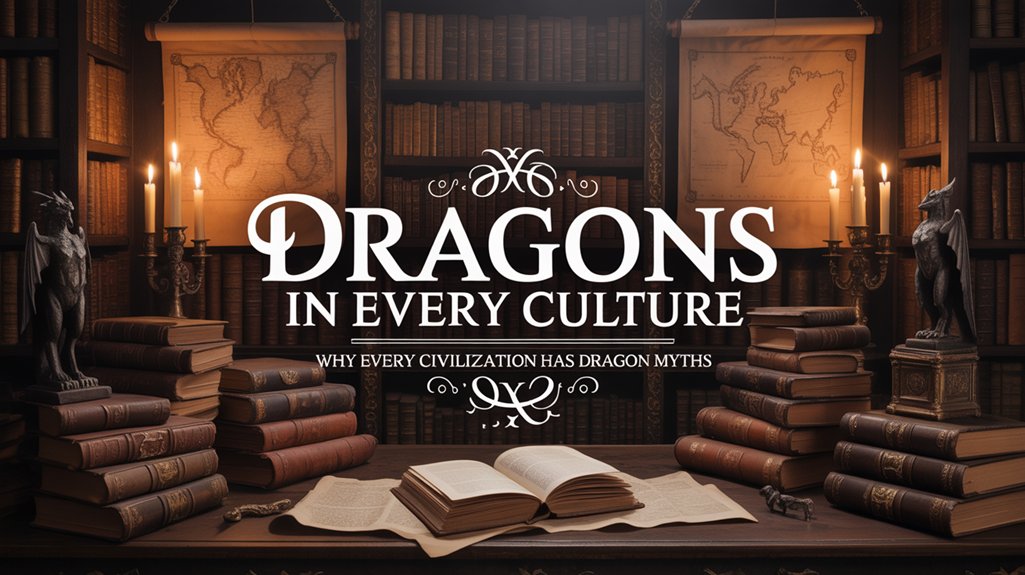Just as you might find yourself caught between two competing impulses, the ancient Greeks created centaurs to embody this very human struggle. You’ll discover these remarkable creatures weren’t simply horsemen viewed from afar, as some historians suggest, but complex symbols of humanity’s eternal battle between civilization and savagery. Through their legends, you’ll encounter noble teachers like Chiron and fierce warriors who challenged the boundaries between man and beast, setting the stage for one of mythology’s most fascinating narratives.
Table of Contents
ToggleKey Takeaways
- Centaurs were mythical creatures with human torsos and horse bodies, symbolizing the eternal struggle between civilization and wild nature.
- According to Greek mythology, centaurs originated from the union of Ixion and the cloud nymph Nephele.
- Famous centaur Chiron served as a wise teacher to Greek heroes, contrasting with his more savage brethren.
- The Centauromachy battle between centaurs and Lapiths highlighted their reputation for violence and untamed behavior.
- Centaurs possessed extraordinary physical abilities, combining human intelligence with equine speed and strength.
Origins and Birth of the Centaur Legend

According to ancient Greek mythology, centaurs emerged from the union between Ixion, king of the Lapiths, and a cloud nymph named Nephele, whom Zeus had shaped to resemble his wife Hera. From this unconventional pairing came the first centaurs, creatures with the upper body of a human and the lower body of a horse.
You’ll find that the mythical horse human origin story reflects deeper cultural significance. Ancient Greeks weren’t alone in creating hybrid creatures – primitive tribes’ mythological beliefs often included similar beings that merged human and animal forms. These tales likely arose from early encounters between settled Greeks and nomadic horse-riding tribes from the north, whose skilled horsemanship appeared supernatural to those who’d never seen mounted warriors.
The centaurs’ dual nature – part civilized human, part wild horse – symbolizes humanity’s eternal struggle between reason and instinct, civilization and wilderness, making them enduring symbols of untamed freedom.
Physical Characteristics and Abilities
These legendary hybrid beings possessed remarkable physical attributes that set them apart from both humans and horses. You’ll find that a centaur’s upper body displayed a muscular physique with the strength of multiple men, while their equine lower half provided incredible speed and stamina that surpassed ordinary stallions.
What’s particularly fascinating is how centaurs mastered their dual nature. They could wield weapons with human hands while galloping at full charge, making them formidable warriors. Their heightened senses included exceptional night vision and acute hearing, while their powerful legs enabled them to leap across ravines and navigate treacherous mountain paths with ease.
You’re looking at creatures who could draw a bow at full gallop, carry heavy loads without tiring, and survive in harsh wilderness conditions. Their unique anatomy granted them advantages in both combat and daily life, combining human intelligence with equine power in perfect synthesis.
Famous Centaurs in Greek Mythology
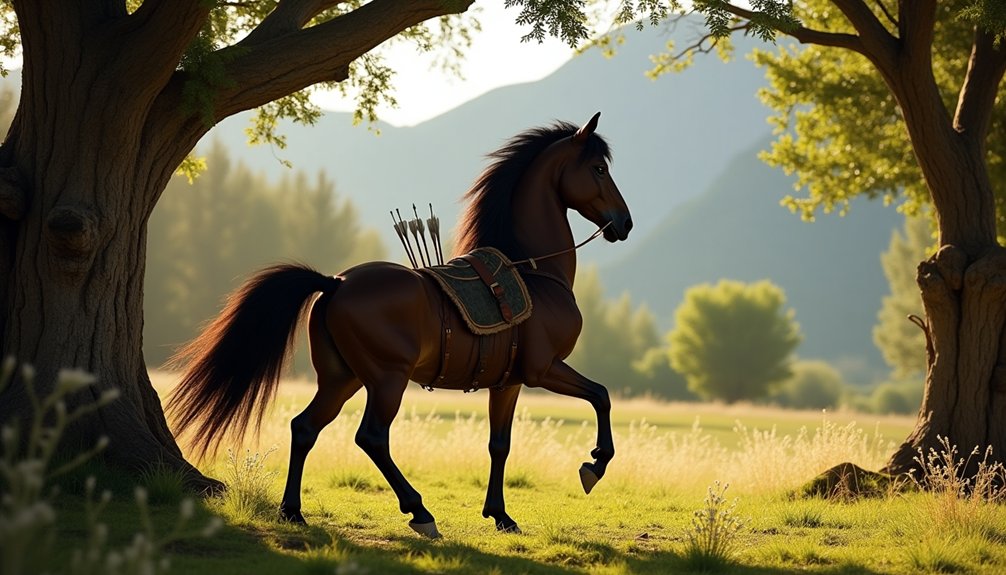
Legends of Greek mythology feature several prominent centaurs who left indelible marks on ancient tales. Among them, you’ll find Chiron, who stands apart from the ferocious centaur tribes as a wise teacher and healer. He’s renowned for mentoring Greek heroes like Achilles, Jason, and Asclepius in medicine, music, and warfare.
Another notable figure is Nessus, whose tragic encounter with Hercules led to the hero’s eventual death through a poisoned cloak. Among the mythical centaur families, Pholus earned recognition for his hospitality to Hercules, though this kindness inadvertently sparked a violent conflict with other centaurs. You’ll also encounter Eurytion, whose attempted kidnapping of Hippodamia at her wedding to Pirithous ignited the famous Centauromachy – a devastating battle between centaurs and Lapiths. These legendary figures exemplify the complex nature of centaurs in Greek mythology, ranging from savage warriors to enlightened mentors.
The Battle Between Centaurs and Lapiths
The infamous Centauromachy erupted at the wedding feast of King Pirithous of the Lapiths and his bride Hippodamia, when the centaur guest Eurytion, intoxicated by wine, attempted to abduct the bride. This incident unleashed the brutish nature of centaurs, leading to a devastating battle that you’ll find depicted in numerous ancient Greek artworks.
The battle’s key aspects reveal the centaurs’ violent tendencies:
- The centaurs, overwhelmed by wine and lust, attempted to kidnap more Lapith women, showing their inability to control their bestial instincts
- Theseus, friend of Pirithous, joined the Lapiths in fighting against the savage centaurs
- The Lapiths ultimately triumphed, driving the centaurs from Thessaly into exile
- This conflict became a powerful metaphor for the eternal struggle between civilization and barbarism
The Centauromachy stands as a cautionary tale about the dangers of unchecked passion and the importance of maintaining human reason over animal instinct.
Chiron: The Wise Teacher of Heroes

Among all centaurs in Greek mythology, Chiron stands uniquely apart as a paragon of wisdom and civility. Unlike his wild brethren, you’ll find him renowned for his intellect, healing abilities, and masterful teaching skills that shaped ancient Greece’s greatest heroes.
As the legendary centaur teacher, Chiron’s unique abilities encompassed medicine, music, prophecy, and warfare. You can trace his influence through the achievements of his famous pupils: Achilles, whom he taught the art of combat; Jason, who learned leadership before seeking the Golden Fleece; and Asclepius, who mastered healing under his guidance.
While most centaurs dwelt in savage brutality, Chiron created a sanctuary of learning on Mount Pelion. You’ll discover that his immortal lineage – born of Kronos and the nymph Philyra – set him apart from other centaurs, granting him divine wisdom that he freely shared with those seeking knowledge. His legacy endures as the archetypal wise mentor in classical mythology.
Symbolism and Cultural Significance
Beyond their physical duality, centaurs embody profound symbolic meanings in Greek mythology and subsequent cultural interpretations. Their symbolic duality represents humanity’s constant struggle between our civilized nature and our primal instincts, serving as powerful allegorical representations of this internal conflict.
You’ll find centaurs appearing throughout history as symbols that represent:
- The tension between rational thought and unbridled passion
- The bridge between humanity’s connection to both nature and civilization
- The dangerous yet alluring aspects of untamed wilderness
- The balance between intellectual pursuit and physical power
When you examine centaurs in literature and art, you’ll discover they’re often used to explore themes of self-control, wisdom, and the consequences of giving in to base desires. Their enduring presence in modern culture continues to remind us of our own dual nature – the constant push and pull between our civilized aspirations and our wilder impulses.
Centaurs in Ancient Art and Literature
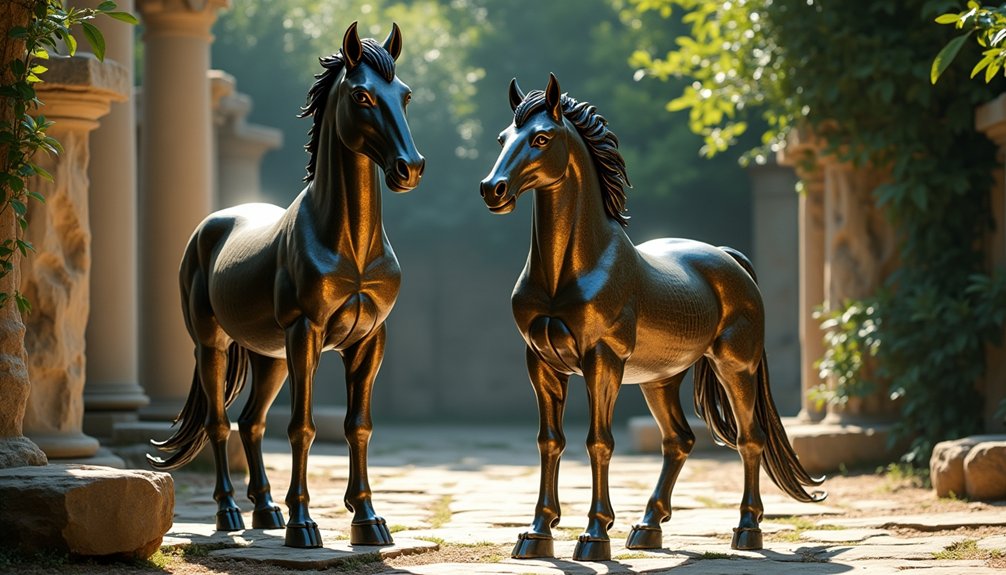
From their earliest depictions in Archaic Greek art to their complex portrayals in classical literature, centaurs have maintained a prominent position in ancient Mediterranean visual and literary traditions. You’ll find these mythological beings adorning countless Greek vases, temple friezes, and marble reliefs, where artistic depictions often showcase their dual nature through dynamic battle scenes and revelry.
When you explore ancient literature, you’ll discover centaurs in Homer’s works and later Roman poetry, where they embody both wisdom and savage nature. The mythological symbolism becomes particularly evident in works featuring Chiron, the legendary teacher of heroes, who stands apart from his wilder brethren. You can trace their artistic evolution from simple black-figure pottery to intricate Hellenistic sculptures, where craftsmen captured their raw power and untamed spirit. The Parthenon’s metopes notably feature the Centauromachy, demonstrating how these creatures became central to classical narratives about civilization versus barbarism.
Modern Interpretations and Pop Culture References
Modern pop culture has reimagined centaurs in countless fantasy movies, video games, and tabletop role-playing games, including prominent appearances in “Harry Potter,” “Chronicles of Narnia,” and “World of Warcraft.” You’ll find these mythical beings depicted across numerous comic book series and graphic novels, where artists often experiment with unique interpretations of centaur anatomy and culture. Fantasy creators have expanded upon the classical Greek portrayal, giving centaurs new abilities, societies, and personality traits that appeal to contemporary audiences.
Fantasy Movies and Games
Popular culture has embraced centaurs as recurring characters in numerous fantasy films, video games, and interactive media. You’ll find computer generated centaurs in blockbuster franchises like “The Chronicles of Narnia” and “Harry Potter,” where they’ve transcended traditional fantasy movie tropes to become complex, nuanced characters.
- The “Percy Jackson” series features centaurs as mentors and warriors, particularly the beloved character Chiron
- “World of Warcraft” lets you explore vast territories populated by various centaur tribes
- The “Heroes of Might and Magic” game series depicts centaurs as skilled archers and cavalry units
- Disney’s “Fantasia” showcases centaurs in its “Pastoral Symphony” segment, blending classical mythology with animation
Beyond mere entertainment, these modern interpretations have helped preserve and reinvent centaur mythology for contemporary audiences, keeping these ancient legends relevant and engaging.
Comics and Graphic Novels
Countless comic books and graphic novels have reimagined centaurs through bold artistic interpretations and compelling storylines. You’ll find these mythical beings featured prominently in Marvel Comics’ “Incredible Hercules” series and DC Comics’ “Wonder Woman,” where they’ve evolved beyond their classical Greek origins.
Comic book depictions often portray centaurs as complex characters with diverse personalities, from noble warriors to cunning adversaries. In graphic novel interpretations like “Mythology” by Alex Ross and “Age of Bronze” by Eric Shanower, you’ll discover meticulously researched renditions that blend historical accuracy with contemporary storytelling. These modern adaptations have transformed centaurs from simple mythological creatures into nuanced characters that explore themes of duality, identity, and the eternal struggle between civilization and nature.
Frequently Asked Questions
Do Centaurs Sleep Standing up Like Horses or Lying Down Like Humans?
You’ll find limited evidence about centaur sleeping positions, but given their unique dietary requirements and hybrid anatomy, they likely alternated between standing and reclining – adapting both human and equine resting behaviors for comfort.
Can Female Centaurs Give Birth to Human Babies?
You won’t find mythological offspring between centaurs and humans since female centaurs possess equine physiology in their reproductive system. They’d only bear centaur foals, maintaining their unique hybrid species within Greek mythology.
What Happens When Centaurs Get Sick – Do They Need Veterinarians?
You’d need both human and veterinary care since you’ve got two distinct anatomies. Your dietary requirements are complex too – you’ll require balanced nutrition for both your human torso and equine body systems.
How Do Centaurs Maintain Personal Hygiene, Especially Their Horse Parts?
You’ll spend 40% of your self-care time on horse-half maintenance. Your daily grooming practices include brushing your coat, cleaning hooves, and washing your tail – similar to equine hygiene but with human self-awareness.
What Kind of Clothing or Armor Would Protect Both Human and Horse Portions?
You’ll need specialized armor combining horse-mounted barding for your equine half with traditional humanoid breastplates above. The transition point at your waist requires flexible chainmail to allow natural movement during combat.
Conclusion
You’ll find that centaurs have maintained their grip on human imagination for over 3,000 years, with archaeological evidence showing their earliest artistic depictions dating to 750 BCE. Their enduring legacy spans more than 15,000 documented appearances across classical literature, medieval manuscripts, and modern media. Whether as Chiron’s wisdom or the untamed wilderness, these hybrid beings continue to symbolize humanity’s eternal struggle between rationality and instinct.

